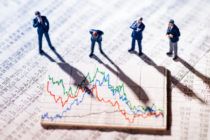When the sustainable development goals were launched in 2015, many impact investors saw them as a useful framework for determining whether or not an investment creates a positive social or environmental outcome.
Using an SDG Credits framework, asset managers are able to construct credit portfolios that are diversified across issuers and sectors, and which make a clear positive contribution to the SDGs, while also delivering attractive financial returns for investors.
SDG screening helps reduce downside risks in credit portfolios, as it separates the wheat from the chaff and prevents investors from investing in companies with outmoded business models that have come under severe pressure.
That is the theory anyway – but is it working in practice and is it having the desired impact?
Jan Anton van Zanten, SDG strategist at Robeco, believes so; but argues that there is still some way to go for both investors and the companies they support.
“Global progress in meeting the 17 sustainable development goals has been mixed, and many lessons have been learned since their adoption by United Nations member states in 2015.”
Investors’ role
He says a key lesson is that investors are essential to meeting the goals. Allocating investment capital to companies that contribute to this global to-do list, as well as avoiding financing those whose practices or products are not aligned with them, helps ensure progress.
“SDG Credit strategies allow investors to allocate capital to companies that can help achieve the goals. This can mean buying the bonds of companies that contribute to one or more of the SDGs and avoiding financing the companies that are not in line with them,” van Zanten adds.
Tancredi Cordero, chief executive of Kuros Associates, is supportive of SDG Credit strategies but has identified some challenges
“It’s hard to generalise but I’d say that, by-and-large, we are not there yet. Fund managers have to constantly tussle in between the risk of achieving SDG goals with poor financial performance and not achieving the goals but at least delivering a decent profit and loss. Furthermore, SDG goals are now championed and fledged by many companies and funds but most of these companies-which are also the holdings of the ESG/Impact funds-are currently in a transition period rather than in a situation of fully meeting the SDG goals that they aim for.”
Defined targets
Having a concrete set of goals with underlying targets make them a good, useful blueprint for sustainable investing, van Zanten maintains. “The SDGs enable investors to clearly show how they allocate clients’ capital to companies that provide solutions to sustainability challenges.”
Cordero largely agrees they are a useful blueprint – but has some reservations.
“Absolutely they are in principle, but again SDGs are more qualitative milestones than quantitative and there are many ways to achieve them in a direct or indirect fashion.
“For instance, by resolving illiteracy and lack of education you’d tackle-and possibly solve in some cases-at least half a handful of other problems that are targeted by other SDG goals. Nevertheless, in finance we have this obsession with standardisation. I am afraid that when it comes to problems related to human behaviour hardly anything can be standardised and so for the time being SDGs, although incredibly important, remain only blueprints at best for now.”
More progress required
Van Zanten argues that progress has been made on the SDG track but insists -as it stands – it’s far from enough.
“The SDGs have spurred some progress, with examples being an increased number of women elected to parliaments, a higher share of energy consumption being sourced from renewables and more of the world’s oceans now being legally protected.”
Yet at the same time, he says, the challenges are – unfortunately – alarming. “Reports on the first phase of the SDG agenda (2015–2020) show unequivocally that progress towards achieving the SDGs has been slow in all parts of the world. Meanwhile, the covid-19 pandemic is an unparalleled health challenge with dire economic consequences.”
He makes the point that covid-19 has proven to be an excellent stress test because it lays bare the relevance and importance of the SDG agenda.
“The shared SDG agenda presents the best possible approach to managing covid-19 with the objective of ensuring that, now and in the future, we nurture human well-being while safeguarding environmental and economic sustainability.”
He adds: “Moreover, achieving the SDGs will create a more stable world in which the likelihood of future crises is lower and the ability of societies to cope with hazards is stronger.”
Cordero agrees that covid has been a wakeup call, particularly in the field of sustainability, SDGs and ESG.
“I am not sure that we can call it a stress test but the pandemic has certainly made people much more aware of the problems facing our planet and societies. It is extraordinary what people can realise when they are confined into a room. Nevertheless, there’s much more that can be done, and I hope investors will keep to their resolutions and commitments”.
Investment opportunities
Many argue that the 17 SDGs present a huge opportunity to invest in the sustainable future of people and the planet.
As van Zanten outlines, the opportunities cover a wide array of areas such as infrastructure, housing, food and medicine, renewable energy, providing finance and insurance to those that need it, and finding means to cut waste.
He points to one estimate that the SDGs offer market opportunities of as much as $12trn per year. They also provide a means of identifying businesses that fail to recognise the implications of the transition to a lower-carbon economy and are hence rendered unviable by changing consumer demand or regulation.
Moving from inputs to impacts
Now is the time to shift from inputs to impacts, van Zanten urges. This means not only quantifying the value of investments to determine the impact on the SDGs, but also look further to assess whether the investments made improve lives and promote environmental sustainability.
As an example, he says that the carbon footprint for each €100m invested in the Robeco Global SDG Credit strategy is significantly lower than the carbon footprint of a similar-sized investment in the Bloomberg Barclays Global Aggregate Corporate Bond Index. “We estimate this difference to be equivalent to the annual CO2 emissions produced by 1,513 cars.”
Identifying tangible benefits is an important factor in increasing the momentum of SDG investing.







